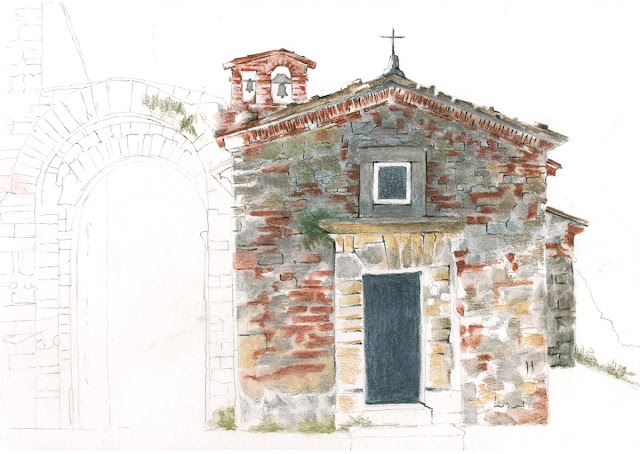At my Rhode Island Watercolor Society Demo I was asked how do watercolor pencils differ from colored pencils? Watercolor pencils are made up of pigment plus a water-soluble binder that dissolves in water and mimics the characteristics of paint. Traditional colored pencils are comprised of pigment and a wax based or oil based binder that doesn't dissolve in water.
The pencils layer differently; water-soluble pencils are more opaque especially when water is added. Traditional colored pencils have a smooth or waxy feel as they glide over paper. You can burnish waxy colored pencils (applying heavy pressure or burnishing with a blender pencil to create a smooth surface) but not watercolor pencils. Traditional wax based colored pencil pigment is more translucent when applied and layered.
At the demo, I worked on these two pieces using different brands of watercolor pencils.
These are my two reference photos for what I worked on.This first piece is from a photo I took this photo in Volterra, Italy. I really like the way the light is hitting the old stone building and producing a variety of color and shadow. Can I achieve this with watercolor pencil? I Hope so! For this painting, I am working on Arches Aquarelle 140 lb hot press watercolor paper in a 7x10" block and using my set of 12 Derwent Graphitint Pencils. I chose the Graphitint pencils for their muted tones and colors that would compliment the stone on the buildings.
The magnolia blossom is also on Arches Aquarelle hot press 140 lb, but a sheet I cut to size and taped to a board. I worked the magnolia using Caran d'Ache Supracolor and Derwent Inkense pencils. I started with the softer colors of the flower and then worked around the flower with some darker greens to make the light tones of the flower to stand out. You can see how I began using the watercolor pencil dry and then added water with a brush to move the paint around.
I had a question from the group asking if I use watercolor pencil to draw my image on the paper and explained that I like to draw with graphite pencil (which is also easy to erase). Drawing with dry watercolor pencil might work as long as water isn't added to blur or erase drawing lines.
Often watercolor painters like to mix their own greens by combining yellow or ochre with blue. I had a second question about whether it is possible to mix greens in this same way with watercolor pencil, so I gave it a try. It is possible but would seem to be more difficult as I didn't have good luck.
I brought the two pieces of artwork (below) and had questions on these. The first drawing of the cherries is on Ampersand Pastelbord created in watercolor pencil and colored pencil. I created a video of this piece for Ampersand, if you'd like to you can view it here. The second drawing of the coffee cup is on Ampersand Aquabord with watercolor and watercolor pencil. Both of these paintings are sealed with varnish so they don't have to be framed under glass.







No comments:
Post a Comment